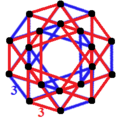The tops of the 5-cells in this honeycomb adjoin the bases of the 5-cells, and vice versa, in adjacent laminae (or layers); but alternating laminae may be inverted so that the tops of the rectified 5-cells adjoin the tops of the rectified 5-cells and the bases of the 5-cells adjoin the bases of other 5-cells. This inversion results in another non-Wythoffian uniform convex honeycomb. Octahedral prisms and tetrahedral prisms may be inserted in between alternated laminae as well, resulting in two more non-Wythoffian elongated uniform honeycombs. [6]
This honeycomb is one of seven unique uniform honeycombs [7] constructed by the  Coxeter group. The symmetry can be multiplied by the symmetry of rings in the Coxeter–Dynkin diagrams:
Coxeter group. The symmetry can be multiplied by the symmetry of rings in the Coxeter–Dynkin diagrams:
Rectified 5-cell honeycomb
The rectified 4-simplex honeycomb or rectified 5-cell honeycomb is a space-filling tessellation honeycomb.
Alternate names
- small cyclorhombated pentachoric tetracomb
- small prismatodispentachoric tetracomb
Cyclotruncated 5-cell honeycomb
| Cyclotruncated 5-cell honeycomb |
|---|
| (No image) |
| Type | Uniform 4-honeycomb |
| Family | Truncated simplectic honeycomb |
| Schläfli symbol | t0,1{3[5]} |
| Coxeter diagram |      |
| 4-face types | {3,3,3} 
t{3,3,3} 
2t{3,3,3}  |
| Cell types | {3,3} 
t{3,3}  |
| Face types | Triangle {3}
Hexagon {6} |
| Vertex figure | 
Tetrahedral antiprism
[3,4,2+], order 48 |
| Symmetry |  ×2 ×2
[3[5]] |
| Properties | vertex-transitive |
The cyclotruncated 4-simplex honeycomb or cyclotruncated 5-cell honeycomb is a space-filling tessellation honeycomb. It can also be seen as a birectified 5-cell honeycomb.
It is composed of 5-cells, truncated 5-cells, and bitruncated 5-cells facets in a ratio of 2:2:1. Its vertex figure is a tetrahedral antiprism, with 2 regular tetrahedron, 8 triangular pyramid, and 6 tetragonal disphenoid cells, defining 2 5-cell, 8 truncated 5-cell, and 6 bitruncated 5-cell facets around a vertex.
It can be constructed as five sets of parallel hyperplanes that divide space into two half-spaces. The 3-space hyperplanes contain quarter cubic honeycombs as a collection facets. [8]
Alternate names
- Cyclotruncated pentachoric tetracomb
- Small truncated-pentachoric tetracomb
Truncated 5-cell honeycomb
The truncated 4-simplex honeycomb or truncated 5-cell honeycomb is a space-filling tessellation honeycomb. It can also be called a cyclocantitruncated 5-cell honeycomb.
Alaternate names
- Great cyclorhombated pentachoric tetracomb
- Great truncated-pentachoric tetracomb
Cantellated 5-cell honeycomb
The cantellated 4-simplex honeycomb or cantellated 5-cell honeycomb is a space-filling tessellation honeycomb. It can also be called a cycloruncitruncated 5-cell honeycomb.
Alternate names
- Cycloprismatorhombated pentachoric tetracomb
- Great prismatodispentachoric tetracomb
Bitruncated 5-cell honeycomb
| Bitruncated 5-cell honeycomb |
|---|
| (No image) |
| Type | Uniform 4-honeycomb |
| Schläfli symbol | t0,1,2,3{3[5]} or 2t{3[5]} |
| Coxeter diagram |      |
| 4-face types | t0,1,3{33} 
t0,1,2{33} 
t0,1,2,3{33}  |
| Cell types | Cuboctahedron 
Truncated octahedron 
Truncated tetrahedron 
Hexagonal prism 
Triangular prism  |
| Vertex figure | tilted rectangular duopyramid |
| Symmetry |  ×2 ×2
[3[5]] |
| Properties | vertex-transitive |
The bitruncated 4-simplex honeycomb or bitruncated 5-cell honeycomb is a space-filling tessellation honeycomb. It can also be called a cycloruncicantitruncated 5-cell honeycomb.
Alternate names
- Great cycloprismated pentachoric tetracomb
- Grand prismatodispentachoric tetracomb
Omnitruncated 5-cell honeycomb
| Omnitruncated 4-simplex honeycomb |
|---|
| (No image) |
| Type | Uniform 4-honeycomb |
| Family | Omnitruncated simplectic honeycomb |
| Schläfli symbol | t0,1,2,3,4{3[5]} or tr{3[5]} |
| Coxeter diagram |      |
| 4-face types | t0,1,2,3{3,3,3}  |
| Cell types | t0,1,2{3,3} 
{6}x{}  |
| Face types | {4}
{6} |
| Vertex figure | 
Irr. 5-cell |
| Symmetry |  ×10, [5[3[5]]] ×10, [5[3[5]]] |
| Properties | vertex-transitive, cell-transitive |
The omnitruncated 4-simplex honeycomb or omnitruncated 5-cell honeycomb is a space-filling tessellation honeycomb. It can also be seen as a cyclosteriruncicantitruncated 5-cell honeycomb.
It is composed entirely of omnitruncated 5-cell (omnitruncated 4-simplex) facets.
Coxeter calls this Hinton's honeycomb after C. H. Hinton, who described it in his book The Fourth Dimension in 1906. [9]
The facets of all omnitruncated simplectic honeycombs are called permutohedra and can be positioned in n+1 space with integral coordinates, permutations of the whole numbers (0,1,...,n).
Alternate names
- Omnitruncated cyclopentachoric tetracomb
- Great-prismatodecachoric tetracomb
This page is based on this
Wikipedia article Text is available under the
CC BY-SA 4.0 license; additional terms may apply.
Images, videos and audio are available under their respective licenses.












